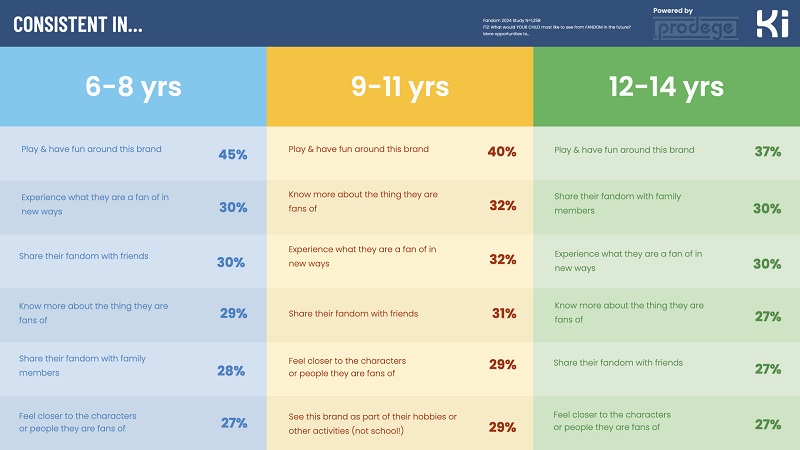A study has revealed that 41 per cent of children want to be more creative, play and have fun with their favourite brands. Fans are looking to take a more active role – with 22 per cent looking to create fan art about their brand, 19 per cent wanting to more actively engage with fandom communities (26 per cent for 12-14 year olds) and 19 per cent are hoping to shape and influence the very trajectory of the brands they love.
The study has been conducted by family-focused strategy agency Kids Industries (KI). The agency’s new global research has taken a deep dive into the mechanics and sentiment around fandom in the age of attention scarcity, and has revealed a big shift from passive to active consumption.
KI’s study was carried out using a data panel from Prodege in January 2024 across 1,644 families with children aged six to 14 across the USA, UK, India and South Korea.
“Our latest study paints a clear picture – the number of children considering themselves a fan of something, is increasing. 76 per cent of children worldwide (rising to 90 per cent in India) now consider themselves fans of something, highlighting the immense potential for brands to harness this passion. Compare that to our global study figures a year ago (though aged six to 13 rather than six to 14 in this study) and we can see there’s been a 13 per cent increase,” said KI strategy director Jelena Stosic.
Stosic further said, “The issue, however, is the overflowing landscape of content. Young people are bombarded with choices, making it harder than ever for brands to capture their attention and hearts. While children have access to more content than ever before (with the study finding 61 per cent of parents even praising its quality), 70 per cent also struggle with information overload, making it crucial for brands to stand out.”
Furthermore, 43 per cent of parents say that their child finds it hard to focus and 34 per cent went on to say that their child almost never watches a full episode from start to finish. So, what can brands do to cut through the noise? The answer lies in creating genuine human connections, being more open to co-creations and fan influence and generating immersive and social experiences. After all, our study found that 98 per cent of children’s fandoms involve people, often seen as cool, happy, friendly, inspiring and brave.”
Discovery: At this time when kids are increasingly browsing social content platforms where algorithms serve them content based on their interest, a significant 38 per cent of children are autonomously immersing themselves in various fandoms. Yet, the influence of their online and in-person friends, contributing 23 per cent and 27 per cent respectively, along with the pivotal role of family recommendations (33 per cent), cannot be overlooked – especially in the USA where familial influence rises to 46 per cent. Remaining a constant presence in their lives – be it through online platforms, gaming experiences, or social media, also proves to be an important factor in discovery – 30 per cent. Furthermore, 21 per cent find their fandoms through advertisements and promotions and 18 per cent are introduced through school activities.
Moving from spectators to active participants: Fandom now stretches beyond passive consumption. Today’s children crave participation and influence. 41 per cent want opportunities to play and have fun around their favourite brands, while 19 per cent want to impact the direction of their fandoms. This shift demands a move from traditional marketing to creating participatory experiences.
Notably in the UK a huge 81 per cent of children want to engage with as many things about the brand they can get their hands on (games, videos, collectables, etc.).
Unleashing creativity, providing tools for self-expression: The research showcases the rise of user-generated content (UGC), with 52 per cent of children creating their own fan art or content. 42 per cent even participate in contests and challenges. Particularly noteworthy is a trend in South Korea where 55 per cent of children said they were learning new skills with the brand / personality they were a fan of or incorporating it into their other hobbies.
Brands can empower this creativity by providing tools and platforms for self-expression, fostering deeper levels of engagement and loyalty.
Shared experiences strengthen fandoms: Fandoms thrive on shared experiences, and family and friends play a crucial role. Sharing fandoms with loved ones is a key driver, with 29 per cent planning to do so in the coming year. Creating immersive moments and shared touchpoints – physical or digital – can forge lasting memories and solidify these connections.
The future of fandom, 2024 and beyond: Looking ahead, the study found that 31 per cent of children hope to experience their fandoms in new ways. 29 cent would like opportunities to deepen their knowledge and connect with others and sharing with family and friends will be a significant driver of engagement.
Developing a sense of closeness to characters and communities will be key.
“The attention scarcity we experience today is changing the way fandoms are built. To build and harness the strongest fandoms, brands need to focus on key opportunities that give higher emotions, attention and, therefore, build memories, too: being more personal, more open, more immersive and social. Fandom unites across generations, and by understanding the core emotional drivers, brands can unlock powerful opportunities to connect with young audiences in meaningful ways. Developing fans doesn’t come without its challenges – it’s a complex topic – but together with our service – The Fandom Model – and accompanying insights, we can help brands to activate a number of levers and better engage their audiences,” Stosic concluded.



